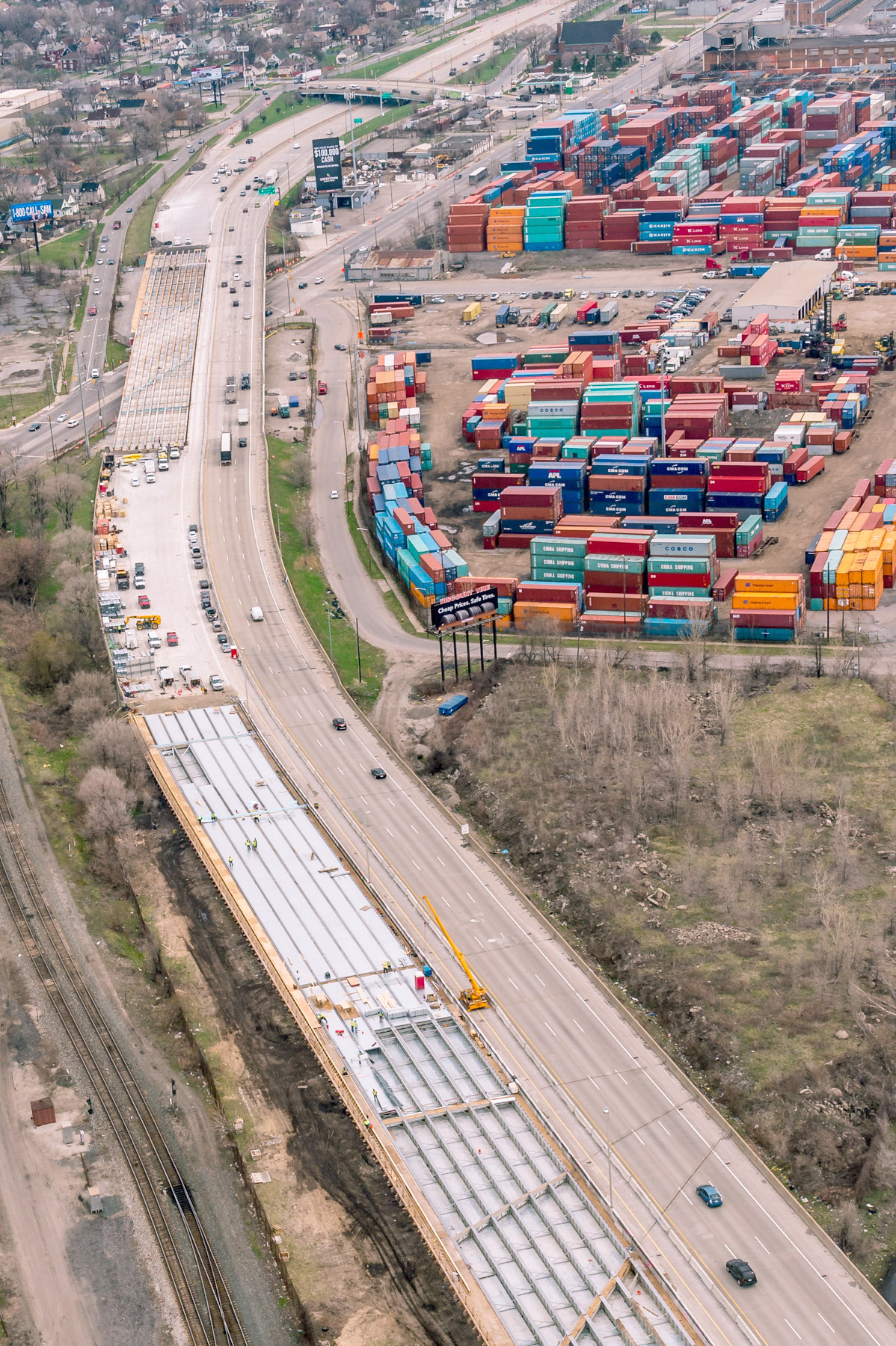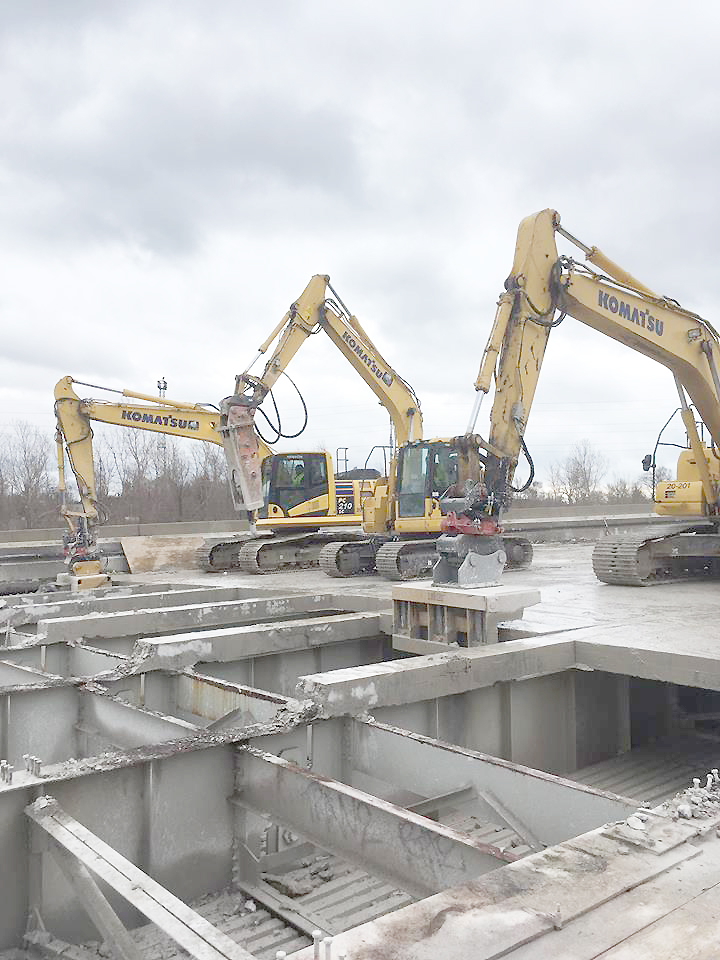Trades clearing the deck on Rouge River Bridge revamp
Date Posted: April 28 2017
DETROIT - After 50 years of having its concrete deck broken down by trucks of 18 wheels or more, road salt, and the freeze-and-thaw cycle, the I-75 Rouge River Bridge is finally getting the attention it deserves.
The Michigan Department of Transportation is investing an estimated $165 million in major repairs to that bridge, as well as other portions of I-75 from Detroit to Brownstown Township over a two-year period. The "I-75 Rouge River Detroit-Downriver Connection" project began earlier this year, and scores of building trades workers have been on the project, removing the existing bridge decking, setting up concrete forms and installing sheet piling.
With community input, MDOT made the decision to first shut down and repair the southbound lanes, which will give the highway workers safer and easier access to their worksite. When those southbound lanes are complete, they will reopen and traffic will shift to those lanes, and work will commence on the northbound lanes. Traffic will only move in one direction, north, during the duration of the project.
"Safety is our No. 1 priority, for both the men and women on the job and for the motorists," said MDOT spokeswoman Diane Cross. "We see it all too often, distracted drivers not paying attention to flashing lights or the people wearing orange vests," so it's safest to separate them.
She added that traffic could have become gridlocked if a serious accident occurred on the bridge, and it's quite possible emergency vehicles wouldn't be able to get through. So southbound traffic is managing its way Downriver through a combination of surface streets and the circuitous designated freeway detour.
The bulk of the project is focused on the eight-lane Rouge River Bridge. It opened in 1967 at a cost of $25 million as a gateway to the Downriver area. The original pavement was replaced in this area in the early 2000s. The bridge carries 37 million vehicles per year, of which 15 percent are trucks. The project includes three I-75 interchanges: at Schaefer Highway, Dearborn Street and Springwells Street.
"The original bridge deck is at the end of its useful service life," said MDOT Engineer Bill Erben. "MDOT Maintenance has been required to patch areas where the surface concrete has deteriorated."


The Michigan Department of Transportation is investing an estimated $165 million in major repairs to that bridge, as well as other portions of I-75 from Detroit to Brownstown Township over a two-year period. The "I-75 Rouge River Detroit-Downriver Connection" project began earlier this year, and scores of building trades workers have been on the project, removing the existing bridge decking, setting up concrete forms and installing sheet piling.
With community input, MDOT made the decision to first shut down and repair the southbound lanes, which will give the highway workers safer and easier access to their worksite. When those southbound lanes are complete, they will reopen and traffic will shift to those lanes, and work will commence on the northbound lanes. Traffic will only move in one direction, north, during the duration of the project.
"Safety is our No. 1 priority, for both the men and women on the job and for the motorists," said MDOT spokeswoman Diane Cross. "We see it all too often, distracted drivers not paying attention to flashing lights or the people wearing orange vests," so it's safest to separate them.
She added that traffic could have become gridlocked if a serious accident occurred on the bridge, and it's quite possible emergency vehicles wouldn't be able to get through. So southbound traffic is managing its way Downriver through a combination of surface streets and the circuitous designated freeway detour.
The bulk of the project is focused on the eight-lane Rouge River Bridge. It opened in 1967 at a cost of $25 million as a gateway to the Downriver area. The original pavement was replaced in this area in the early 2000s. The bridge carries 37 million vehicles per year, of which 15 percent are trucks. The project includes three I-75 interchanges: at Schaefer Highway, Dearborn Street and Springwells Street.
"The original bridge deck is at the end of its useful service life," said MDOT Engineer Bill Erben. "MDOT Maintenance has been required to patch areas where the surface concrete has deteriorated."
Another major portion of the project involves removing and replacing 13 bridges carrying I-75 south of Goddard Road.
The 1.63 mile-long I-75 Rouge River Bridge hardly has the beauty or the charm of Michigan's Blue Water Bridge in Port Huron, the Ambassador in Detroit or the Mackinac Bridge in St. Ignace - but measured by surface area it is the largest span in the state, with 26 square acres of concrete deck. The 100-foot -tall bridge provides a great view of the Detroit skyline, as well as what is probably the most heavily industrialized area in the state. The bridge's main purpose is to move traffic over the Rouge River, which also has three surface street drawbridges to allow for the movement of freighter traffic.
The Rouge River Bridge has provided some dramatic visual evidence of its deck's demise, with gaping see-through holes occasionally opening up in the pavement. There continue to be periodic lane closures on the bridge due to potholes. The existing concrete deck that's being removed is 10 inches thick, including a 1 1/2-inch latex concrete overlay, to be replaced with a 9-inch-thick all-concrete deck.
While the deck is in rough shape, the span's concrete piers and 39 million pounds of structural steel are generally in good condition.
"There is a minor amount of work being done to the bridge piers as part of this contract, as the available funds are being devoted to the element of the bridge thought to be the highest priority, i.e., the deck," Erben said. "The piers are structurally sound, though a project is being developed for patching the surface of the piers that will be let to contract when funds are available."
The cost of replacing the entire Rouge River bridge would be more than $400 million - vs. just replacing the deck for $90 million. MDOT says by replacing the deck, the life of the structure will be extended another 50 years at a fraction of the cost for a bridge replacement. "Over the past 40 years the substructure units have been repaired, along with some deck work," MDOT says. "These past improvements have helped to maintain the structure in a condition that avoids the need for a costly replacement."
Erben said there are a few additional safety concerns working on a freeway bridge as opposed to a freeway ditch, and safety meetings are held regularly with the contractors and MDOT. "So far, so good," Erben said about the project. "It is a relatively delicate operation to saw the bridge deck up in slabs and haul it away, and the effort made to date has been impressive."
Erben said there are a few additional safety concerns working on a freeway bridge as opposed to a freeway ditch, and safety meetings are held regularly with the contractors and MDOT. "So far, so good," Erben said about the project. "It is a relatively delicate operation to saw the bridge deck up in slabs and haul it away, and the effort made to date has been impressive."

CONCRETE REMOVAL, decking replacement and form work have been the major tasks so far in the “I-75 Rouge River Detroit-Downriver Connection,” a project which includes the rehabilitation of the I-75 bridge over the Rouge River. Completed in 1967, the bridge is 8,627 feet long, and its 26 acres of concrete deck area is the most of any bridge in Michigan. Shown above is a stretch south of the Springwells overpass. Photo credits: Jim LeMay/MDOT Photography Unit

SOME 39 MILLION pounds of structural steel support the I-75 Rouge River Bridge, and unlike the concrete deck that is being removed, most of it is in good condition.
